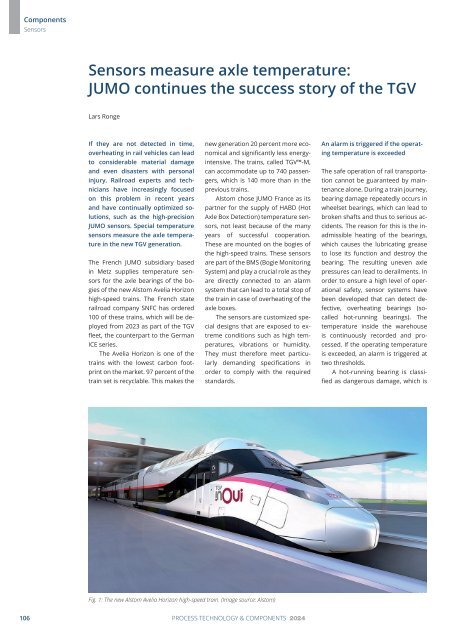PuK - Process Technology & Components 2024
A technical trade magazine with a history of more than 60 years.
A technical trade magazine with a history of more than 60 years.
You also want an ePaper? Increase the reach of your titles
YUMPU automatically turns print PDFs into web optimized ePapers that Google loves.
<strong>Components</strong><br />
Sensors<br />
Sensors measure axle temperature:<br />
JUMO continues the success story of the TGV<br />
Lars Ronge<br />
If they are not detected in time,<br />
overheating in rail vehicles can lead<br />
to considerable material damage<br />
and even disasters with personal<br />
injury. Railroad experts and technicians<br />
have increasingly focused<br />
on this problem in recent years<br />
and have continually optimized solutions,<br />
such as the high-precision<br />
JUMO sensors. Special temperature<br />
sensors measure the axle temperature<br />
in the new TGV generation.<br />
The French JUMO subsidiary based<br />
in Metz supplies temperature sensors<br />
for the axle bearings of the bogies<br />
of the new Alstom Avelia Horizon<br />
high-speed trains. The French state<br />
railroad company SNFC has ordered<br />
100 of these trains, which will be deployed<br />
from 2023 as part of the TGV<br />
fleet, the counterpart to the German<br />
ICE series.<br />
The Avelia Horizon is one of the<br />
trains with the lowest carbon footprint<br />
on the market. 97 percent of the<br />
train set is recyclable. This makes the<br />
new generation 20 percent more economical<br />
and significantly less energyintensive.<br />
The trains, called TGV-M,<br />
can accommodate up to 740 passengers,<br />
which is 140 more than in the<br />
previous trains.<br />
Alstom chose JUMO France as its<br />
partner for the supply of HABD (Hot<br />
Axle Box Detection) temperature sensors,<br />
not least because of the many<br />
years of successful cooperation.<br />
These are mounted on the bogies of<br />
the high-speed trains. These sensors<br />
are part of the BMS (Bogie Monitoring<br />
System) and play a crucial role as they<br />
are directly connected to an alarm<br />
system that can lead to a total stop of<br />
the train in case of overheating of the<br />
axle boxes.<br />
The sensors are customized special<br />
designs that are exposed to extreme<br />
conditions such as high temperatures,<br />
vibrations or humidity.<br />
They must therefore meet particularly<br />
demanding specifications in<br />
order to comply with the required<br />
standards.<br />
An alarm is triggered if the operating<br />
temperature is exceeded<br />
The safe operation of rail transportation<br />
cannot be guaranteed by maintenance<br />
alone. During a train journey,<br />
bearing damage repeatedly occurs in<br />
wheelset bearings, which can lead to<br />
broken shafts and thus to serious accidents.<br />
The reason for this is the inadmissible<br />
heating of the bearings,<br />
which causes the lubricating grease<br />
to lose its function and destroy the<br />
bearing. The resulting uneven axle<br />
pressures can lead to derailments. In<br />
order to ensure a high level of operational<br />
safety, sensor systems have<br />
been developed that can detect defective,<br />
overheating bearings (socalled<br />
hot-running bearings). The<br />
temperature inside the warehouse<br />
is continuously recorded and processed.<br />
If the operating temperature<br />
is exceeded, an alarm is triggered at<br />
two thresholds.<br />
A hot-running bearing is classified<br />
as dangerous damage, which is<br />
Fig. 1: The new Alstom Avelia Horizon high-speed train. (Image source: Alstom)<br />
106 PROCESS TECHNOLOGY & COMPONENTS <strong>2024</strong>

















